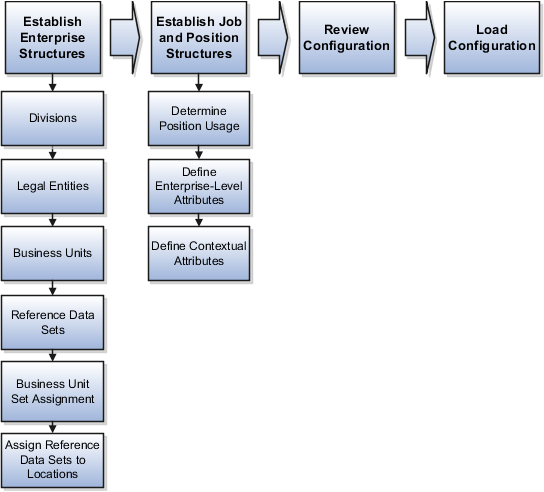How You Establish Enterprise Structures Using the Enterprise Structures Configurator
The Enterprise Structures Configurator is an interview-based tool that guides you through the process of setting up a basic enterprise structure.
By answering questions about your enterprise, the tool creates a structure of divisions, legal entities, business units, and reference data sets that reflects your enterprise structure. After you create your enterprise structure, you also follow a guided process to determine whether to use positions, and whether to set up additional attributes for jobs and positions. After you define your enterprise structure and your job and position structures, you can review them, make any necessary changes, and then load the final configuration.

To be able to use the Enterprise Structures Configurator, you must select the Enterprise Structures Guided Flow feature for your offerings on the Configure Offerings page in the Setup and Maintenance work area. If you don't select this feature, then you must set up your enterprise structure using individual tasks provided elsewhere in the offerings, and you can't create multiple configurations to compare different scenarios.
Establish Enterprise Structures
To define your enterprise structures, use the guided flow within the Establish Enterprise Structures task to enter basic information about your enterprise, such as the primary industry. You then create divisions, legal entities, business units, and reference data sets. The Establish Enterprise Structures task enables you to create multiple enterprise configurations so that you can compare different scenarios. Until you load a configuration, you can continue to create and edit multiple configurations until you arrive at one that best suits your enterprise.
Establish Job and Position Structures
You also use a guided process to determine whether you want to use jobs only, or jobs and positions. The primary industry that you select in the Establish Enterprise Structures task provides the application with enough information to make an initial recommendation. You can either accept the recommendation, or you can answer additional questions about how you manage people in your enterprise, and then make a selection. After you select whether to use jobs or positions, you're prompted to set up a descriptive flexfield structure for jobs, and for positions if applicable. Descriptive flexfields enable you to get more information when you create jobs and positions.
Review Configuration
You can view a result of the interview process prior to loading the configuration. The review results, show the divisions, legal entities, business units, reference data sets, and the management reporting structure that the application will create when you load the configuration.
Load Configuration
You can load only one configuration. When you load a configuration, the application creates the divisions, legal entities, business units, and so on. After you load the configuration, you then use individual tasks to edit, add, and delete enterprise structures.
This table lists the order of creation of business objects by the Enterprise Structures Configurator| Business Object | Task |
|---|---|
| Location | Location Details |
| Division | Manage Divisions |
| Business Unit | Manage Business Units |
| Set Assignment Override | Manage Set Assignments |
| Legislative Data Group | Manage Legislative Data Groups |
| Enterprise | Manage Enterprise HCM Information |
|
Job and Position Flexfield Definitions |
Manage Descriptive Flexfields |
| Legal Entity |
|
| Organization Tree | Manage Organization Trees |